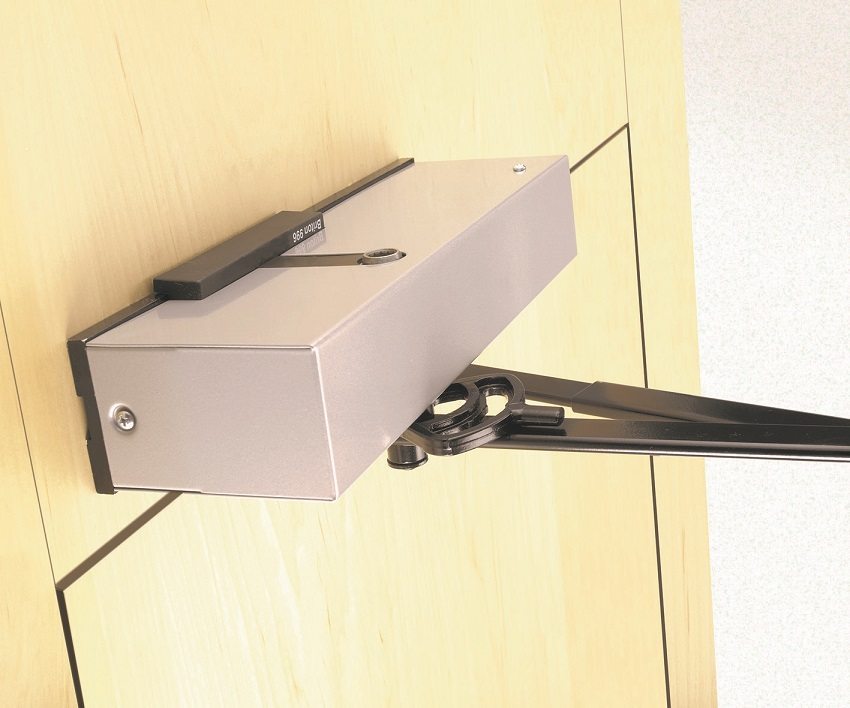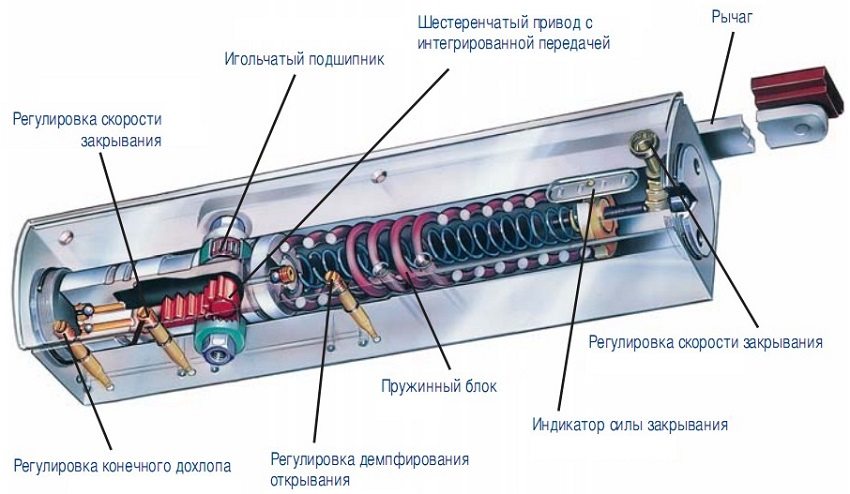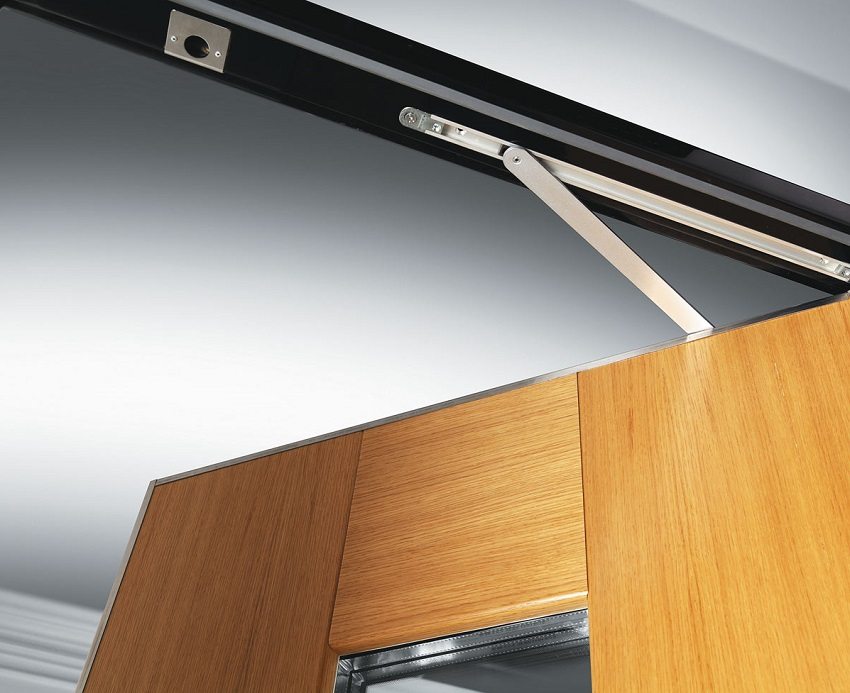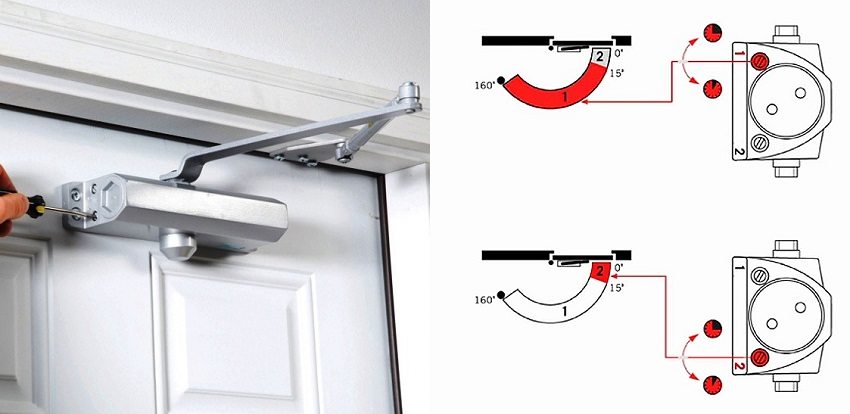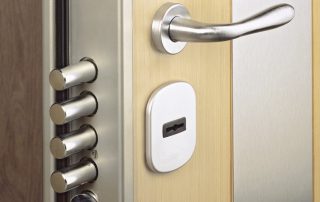Perhaps, today you will not see entrance doors in offices, institutions and industrial buildings that are not equipped with door closers. These devices control the closing of door leaves and protect door fittings, locks and door structures directly from impacts and damage. With their help, the doors will always slowly but surely take the closed position. Closers for entrance doors differ in the type of device and power, taking this into account they are installed on doors of different weight - from light structures to massive metal doors.
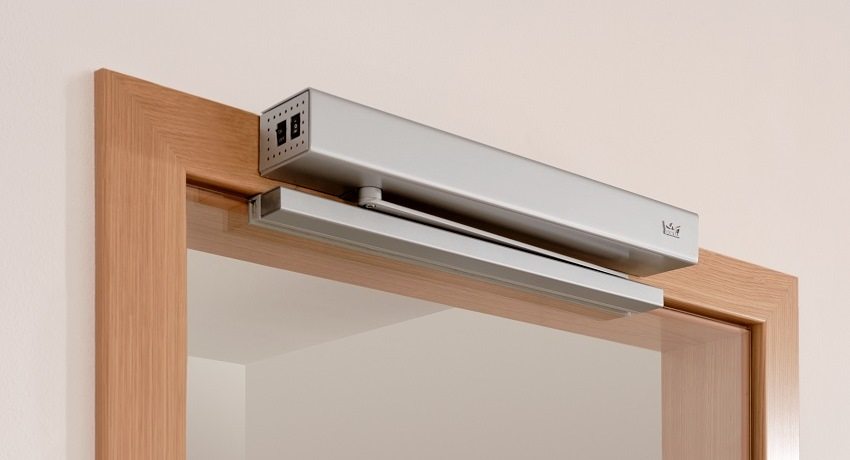
Closers control door closing and protect door fittings, locks and structures from impacts and damage
Content [Hide]
Closers for entrance doors: types of mechanical devices
Given the method and place of fastening door closers for entrance doors, they are divided into the following groups:
- top closers;
- bottom (floor) closers;
- hidden (frame) closers.
Overhead door closers are quite common and versatile door devices. These door closers are mainly used for building entrance doors. They are distinguished by simple installation: the sliding rod and the lever are fixed on the lintel of the door frame, and the body - on the inner upper surface of the door leaf.
The device of the top fastener door closers offered by different manufacturers may differ in the principle of operation. The mechanism with a lever drive and a toothed gear is popular. Another current option is the sliding rod and cam gear door closer.
As for hidden door closers for interior doors, then they are mounted at the stage of production of the doors themselves, the lower closers are installed in the floor, making them almost invisible.
The device and principle of operation of the door closer
The door closer device includes a link arm and the body itself with a mechanism that allows the door to take a closed position. The mechanism consists of a fairly powerful spring, which is compressed due to the force of the piston drive. The spring, usually made of steel, is enclosed in a special capsule. The capsule contains oil, which, when the spring returns to its original position, moves through the hydraulic channels into the working container. This technology provides a smooth and soft door closing.
Adjustment of the door closer is carried out by means of specially designed screws located in the end of the body.When rotating, the screws change the cross-section of the channels, which affects the speed of oil movement and, accordingly, the rate of closing the door.
Improved models of door closers have an additional valve that allows you to hold the movement of the leaf. This happens when the door is opened already at 70 degrees before closing, and just before closing (when up to 15 degrees remains), the movement accelerates, which contributes to the tight pressing of the door. Thanks to this design, the closer copes with the force of the latches on the doors and overcomes the air resistance generated when closing.
There are door closers models equipped with an additional function of blocking door movement. Such a system regulates the spontaneous closing of the door. It is very convenient when it is required to bring large items into the room (furniture, household appliances, etc.). The door opens 90 degrees or more and is fixed until it is pushed to close, after which the door closer mechanism will ensure its smooth and silent closing.
Door closers can perform a number of additional functions, including a delay in door travel for 30 seconds, a coordinator for closing door leaves for door models with more than one leaf, a shock absorber for sudden opening (damper).
Model selection according to the characteristics of door closers
One of the main characteristics by which the choice of door closers is made is their power. In this regard, one should take into account dimensions and a lot of door designs. Closers for street doors with weighty dimensions are selected more powerful, sometimes two door closers are used at once. Closers for an interior door can be less powerful and installed with the upper mounting method. Correctly chosen door closer will ensure correct and durable operation of the door.
When choosing closers for a metal door, you need to find out which mode of operation of the required analogs. Closer mechanisms must ensure proper operation of the device at low and high temperatures. There are models that can withstand severe frosts (down to -40 ° C) and heat (+ 65 ° C).
Useful advice! If the door on which the door closer is selected has non-standard dimensions with a height of more than 2.5 m, it is recommended to choose a device model of a higher class, which guarantees a safety margin.
There is a table of European standards for the classification of door closers. Device classes are marked with the letters EN and the numbers 1-7, which indicate the degree of force of the spring of the mechanism. Based on the table, the most powerful models are EN7 class closers. They are suitable for heavy door structures with a door leaf width over one and a half meters.
How to install door closers
How to install a door closer correctly? For this, it is necessary that high-quality door sheds are cut in and the door itself is installed without distortions. Avoid installing a powerful door closer on plastic doorlightweight or narrow design. In this case, this will affect the service life of the door and the use of additional force when opening it. This also applies to the installation of glass door closers.
Closers are mounted on the door itself or on the door frame and can be installed internally and externally. All products are completed with an installation diagram and instructions for adjusting the door closer. The circuit is made in full size, which is very convenient for error-free mounting. The scheme is fixed with tape directly on the door, the holes are marked on it.Following all the instructions of the instructions, the device body is fixed.

Installing the lever closer on plastic door
Once the device mechanism is secured, start the installation of the slide link arm. It consists of two halves connected by a thread. The length of the lever is adjusted to suit the door opening angle of 90 degrees. If the installation of the door closer is carried out correctly, the door closes evenly and silently.
Useful advice! Following the manufacturer's instructions for the installation and operation of door closers will contribute to the correct and long-term operation of the device from the first minutes of installation.
If you are not completely sure of your skills or you do not have the necessary tools for installation, you should seek help from specialists.
How to adjust door closers
Related article:
|
As for the adjustment of the door closer, the device has two screws for different closing stages. With their help, regulation takes place. The first range of closing is the main movement of the door, the second is the adjustment of the door to the closed position starting from an angle of 15-20 degrees just before closing (adjustment-slamming).
The door opening angle is initially set. To do this, using the screw, select the desired position 90 or 180. After that, the speed of movement of the door leaf is set, which is regulated by the second screw. The door is opened at a set angle and released, and by rotating the second screw, the uniformity of the stroke in the last degrees and the resulting slamming are adjusted.
When adjusting the doors yourself, remember that you should not turn the screw with great effort. Turning the screw a quarter has a noticeable slowdown effect on the door.
In the process of operation of the mechanism, they adjust the door closer with their own hands. If the installation and operation of the closer are carried out correctly, then the adjustment will only be needed when the air temperature changes.
Correct operation of the door closer
Correct functioning of the closer will help the mechanism to serve for a long time. When operating the closer it is not recommended:
- apply force to close quickly;
- prop up or forcefully brake the door;
- swing on the door or pull the lever of the device.
Failure to comply with these recommendations will lead to a quick failure of the closer oil seals, damage to the piston or gear.

When choosing a door closer, it is necessary to take into account the dimensions and weight of the door structure
In the event of a door closer breakdown, repairs are expensive, and long-term operation of the mechanism after it is not guaranteed. You will have to purchase a new device.
Useful advice! When choosing a door closer, consider the need for frequent use of the open door mode, giving preference to a device with the "Hold-open / Delay" function.
If, due to the circumstances, the doors have to be kept open often (for example, when moving or cleaning), it is recommended to install a closer model with a door delay function in the open state. With its help, the door will be fixed for some time in the open position. Such closers are equipped with an additional lever that blocks the oil flow, so that the spring does not expand and the door remains open in the position you want.
For more information on the devices, see the door closer video.
Having installed on their input and interior doors closers, you will forever get rid of the effect of "slamming doors".



